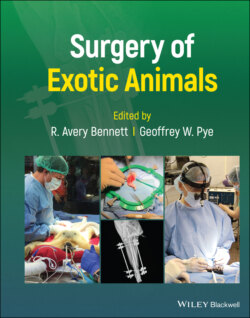Читать книгу Surgery of Exotic Animals - Группа авторов - Страница 109
Ophthalmic Surgery
ОглавлениеFish eyes have marked anatomic differences compared to those of mammals (Kern 2007). Very few fish have eyelids, except some elasmobranchs. They have larger lenses comparatively to mammals of the same size, and the lens protrudes into the anterior chamber, which has implications for cataract surgery (Kern 2007). The posterior segment of the eye contains a falciform process and a choroid rete communicating with the pseudobranch in most species (Copeland and Brown 1976). An important consideration when performing an enucleation is the presence of scleral ossicles in the anterior part of the globe, as in teleosts, and scleral cartilage or scleral calcifications in the posterior part in elasmobranchs (Pilgri and Franz‐Odendaal 2009).
The pupillary light reflex is usually absent, except in elasmobranchs (Duke‐Elder 1958). They have a slow retinomotor reflex that takes up to two hours. During the day, retinal‐pigmented epithelium granules migrate apically in the retinal epithelial cells, cones contract and rods elongate (Burnside et al. 1983). This retinomotor reflex protects photoreceptors from bright light, but rapid exposure of anesthetized patients to a scialytic lamp may impair vision and some authors have recommended covering fish eyes with an opaque material during surgery (Wildgoose 2000).
Figure 5.11 Green spotted pufferfish (Tetraodon nigroviridis) before (a) and after incisor plate occlusal adjustment (b).
Source: Photo courtesy: Companion Avian and Exotic Pet Medicine Service, University of California, Davis.
Figure 5.12 Fluorescein staining of a large corneal ulceration in a lookdown (Selene vomer) associated with repeated trauma on the walls of the exhibit.
Source: Photo courtesy: Companion Avian and Exotic Pet Medicine Service, University of California, Davis.
Corneal ulcers can be highlighted by the use of fluoresceine dye (Figure 5.12). Repair corneal perforations with small diameter suture material and use periorbital tissue to cover peripheral corneal perforations, similar to a conjunctival flap.
Idiopathic gaseous exophthalmia (i.e. not due to gas oversaturation of water) has been treated with pseudobranchectomy. The pseudobranch is located dorsally in the opercular cavity in most teleosts (Harms and Wildgoose 2001). Visually locate the pseudobranch and apply electrocautery on various points to cauterize it.
Some fancy goldfish, such as oranda and lionheads, are bred to have a fleshy outgrowth on the dorsal aspect of the skull and bilaterally in the buccal area, which is called a crown or “wen.” This wen is a hyperplastic epidermal and mucous cell covering of adipose cell deposition in the hypodermis (Angelidis et al. 2006). The wen grows continuously, sometimes covering the eyes and impairing vision. Use a scalpel or electrocautery to excise the periocular tissue (Sladky and Clarke 2016).
